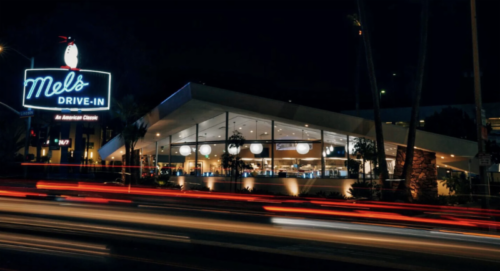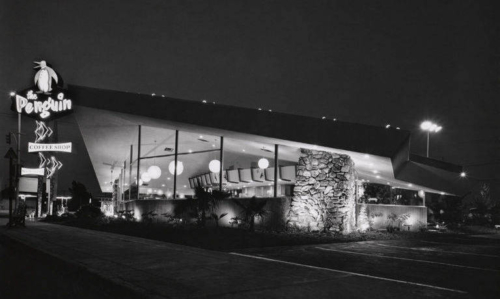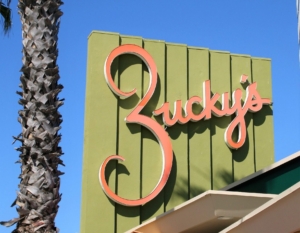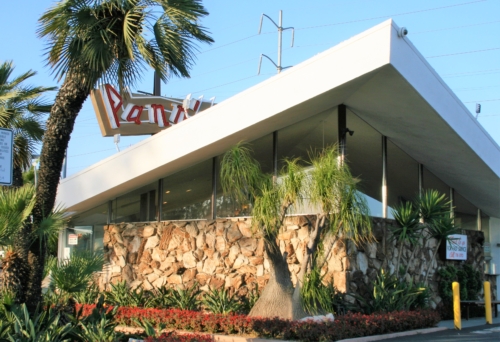Mel’s Drive-In

- Known As
- Penguin Coffee Shop, Googie
- Architect
- Armet & Davis Architects
- Built
- 1959
- Designated
- –
Googie, the futuristic commercial architecture seen on everything from coffee shops to car washes and gas stations across mid-century Los Angeles, perfectly captured the city’s booming car culture and evolution into a decentralized metropolis. Inspired by the aerospace industry and the dawn of the space age, Googie architecture featured gravity-defying roofs, neon lights and glass walls revealing colorful interiors. The use of outsized scripted signage and dynamic shapes in cantilevers, parabolas or boomerangs attracted L.A.’s motorists.

The Penguin Coffee Shop in 1959, designed by Architects Armet & Davis. Photo: Santa Monica Public Library
In Santa Monica, one of the more notable Googie eateries is Mel’s Drive-In, which anchors the corner of Lincoln and Olympic Boulevards — the official terminus for Route 66, the Mother Road. This end-of-the-road beacon opened in 1959 as the Penguin Coffee Shop, which served burgers and malts for 30 years until the building became a dental clinic in 1991. Twenty-five years later, the shuttered facility was reborn as a diner, this time under a Mel’s sign. In 2000, the City of Santa Monica included it in its List of Meritorious Signs.
Steven Weiss, the owner of multiple Mel’s locations around California, was the inspiration behind bringing back the Googie-style building. With his success in rehabilitating other mid-century coffee shops in Hollywood and Sherman Oaks, he set about restoring the original Googie aesthetic, assisted by Googie experts Adriene Biondo and Chris Nichols.
At the Santa Monica Mel’s, Weiss uncovered the original flagstone hidden behind drywall and kept the Penguin-shaped sign that lured travelers for decades. Inside, he brought back the terrazzo floors, as well as counter stools upholstered in leatherette material and cantilevered from a raised terrazzo curb, which serves as a footrest. The Santa Monica Conservancy honored Mel’s with a Historic Preservation Award in 2019.
- Zuckys at 431 Wilshire Blvd. Santa Monica.
- Bowlmor at 234 Pico Blvd, Santa Monica.
Googie architecture has disappeared over the decades, but a few of these historic places remain thanks to preservation and the protections of landmarking. A 25-foot neon wall sign that once bannered Zucky’s 24-hour restaurant on Wilshire Boulevard has been landmarked and preserved as part of what is now a bank branch. The Bowlmor bowling alley in Santa Monica also features a landmarked sign in the Googie style.
The L.A.-based team of Louis Armet and Elden Davis are the most recognized Googie architects, having designed over 4,000 local buildings. Surviving properties include Norm’s in West Hollywood, various Bob’s Big Boy locations, Corky’s in Sherman Oaks and Pann’s in Westchester.
Sources:
Googie Redux: Ultramodern Roadside Architecture by Alan Hess
“The 1959 Googie style restaurant will become a Mel’s Drive-in,” Chris Nichols, Los Angeles Magazine, November 2, 2016.



